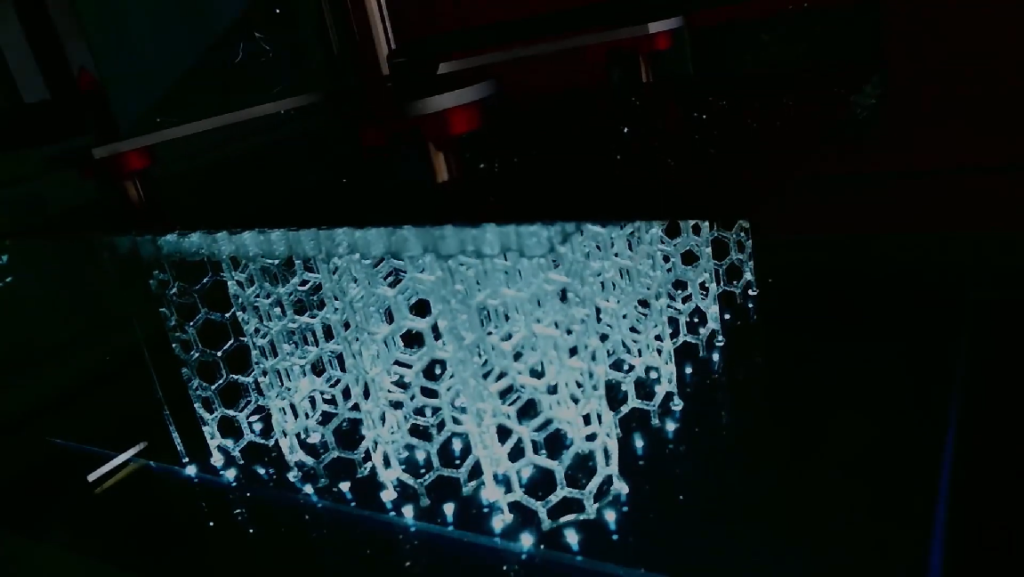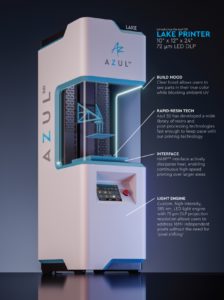Investors Beta Lab, GS Futures, DuPont and others have invested $15 million in a Series A round for Azul3D. Under the leadership of John Hartner, formerly of EnvisionTEC and ExOne, Azul3D has been making significant strides since he assumed his role in June. The company specializes in a vat photopolymerization technique known as high area rapid printing (HARP), which allows for the use of resins that can be flexible or rubber-like and, in some instances, offer properties that surpass those of other vat polymerization components. What sets Azul3D apart, however, is its ambition to become a key partner in large-scale production. The company leverages its Lake 3D printers, which utilize 385nm resins and DLP technology, to manufacture parts. It aims to use the money to scale particularly in electronics and mass customized personalized devices.
“Azul3D is upending the supply chain and manufacturing process, creating products that were never before possible. We invested in this company because it is unlike anything we have seen in the 3D printing space. It has the ability to flip verticals that have long been stagnant,” said Abdulrahman al Olayan, CEO of Beta Lab.
“Azul3D has become very focused on high-value, high-volume applications where we know our 3D printing technology can be a game-changer. This new financing, particularly with the robust valuation step-up, stands out against the current funding environment and shows the excitement surrounding this path and its potential for disrupting manufacturing in targeted industries,” John Hartner.
“This is the most excited I have been about photopolymer 3D printing in a long time,” said AM veteran and investor G. Walter “Wally” Loewenbaum, who has joined the Azul3D board. “With this technology, we have the potential to capture high-value markets and enable innovative new products. I’m excited to be a part of Azul 3D as it enters this next phase.”
Emerging from the lab of Professor Chad Mirkin at Northwestern University, Azul3D has an impressive pedigree. Professor Mirkin is a prolific inventor and researcher, with over 400 patents and six companies to his name, including Azul3D. He has also co-authored over a thousand papers, one of which, published in 2019, serves as the foundation for Azul3D’s technology.
Azul3D’s unique contribution lies in its approach to solving a key challenge in vat polymerization—the interface where the component being built meets the laser. In traditional processes, a polymer film usually separates the liquid resin from the growing component. This film requires removal before adding a new layer, slowing down the build. Carbon tackled this issue with an oxygen-permeable window, creating an unpolymerized resin area between the part and laser, speeding up the printing process under their continuous liquid interface printing (CLIP) technology.
Azul3D, however, utilizes a different tactic—a fluorinated oil as a lubricant at this critical interface. Unlike other methods that require the component to be dislodged from the interface for each layer, Azul3D’s printers keep this fluorinated oil in constant motion and cool it actively. This approach not only enables continuous, high-throughput printing but also offers extra advantages, such as serving as a coolant for the entire print bed. As a result, Azul3D’s technology potentially opens the door for extremely large printers with high processing rates. This is a significant advancement, as heat management has traditionally limited the speed and mass of objects that can be 3D printed in vat polymerization. Furthermore, because Azul3D’s vat doesn’t require oxygen, as in Carbon’s process, it has the flexibility to use resins that are not compatible with other methods.
In the paper that set the stage for Azul3D’s technology, polybutadiene rubber and ceramic-loaded objects were cited as materials used. Given its high speed and ability to utilize a diverse range of resins, Azul3D is clearly a company to watch. The firm boasts a materials library comprising over 400 materials and aims to collaborate with partners to develop application-specific materials. This targeted approach is commendable; instead of creating a limited range of materials that sort of fit everyone’s needs, the company seeks to engineer specific materials for substantial applications. However, this strategy also carries risk; effective business development will be crucial to ensure that Azul3D collaborates with the right partners.
Azul3D has disclosed intriguing information in a white paper, revealing that they have materials suitable for electroless electroplating. This opens up an alternative route for the creation of metal components. The company’s ceramic-loaded resins could also provide advanced properties for high-end applications, adding another layer of potential to their portfolio.
The recent funding raise is not only good news for Azul3D but also a positive indicator for the industry at large. Even in challenging times, venture capitalists are willing to invest in this promising technology, and that’s something that deserves applause.
Subscribe to Our Email Newsletter
Stay up-to-date on all the latest news from the 3D printing industry and receive information and offers from third party vendors.
Print Services
Upload your 3D Models and get them printed quickly and efficiently.
You May Also Like
The Market and Industry Potential of Multi-Material 3D and 4D Printing in Additive Electronics
Additive manufacturing leverages computer-based software to create components for products by depositing either dielectric or conductive materials, layer by layer, into different geometric shapes. Since its birth in the 1980s,...
3DPOD 262: Bio-inspired Design for AM with Dhruv Bhate, Arizona State University
Dhruv Bhate is an associate professor at Arizona State University. There, he looks at structures, materials, and design. Previously, he worked at PADT as well as in the semiconductor and...
3DPOD 261: Tooling and Cooling for AM with Jason Murphy, NXC MFG
Jason Murphy´s NXC MFG (Next Chapter Manufacturing) is not a generalist service; instead, the company specializes in making tooling. Using LPBF and binder jet, the company produces some of the...
3DPOD 260: John Hart on VulcanForms, MIT, Desktop Metal and More
John Hart is a Professor at MIT; he´s also the director of the Laboratory for Manufacturing and Productivity as well as the director of the Center for Advanced Production Technologies....


































